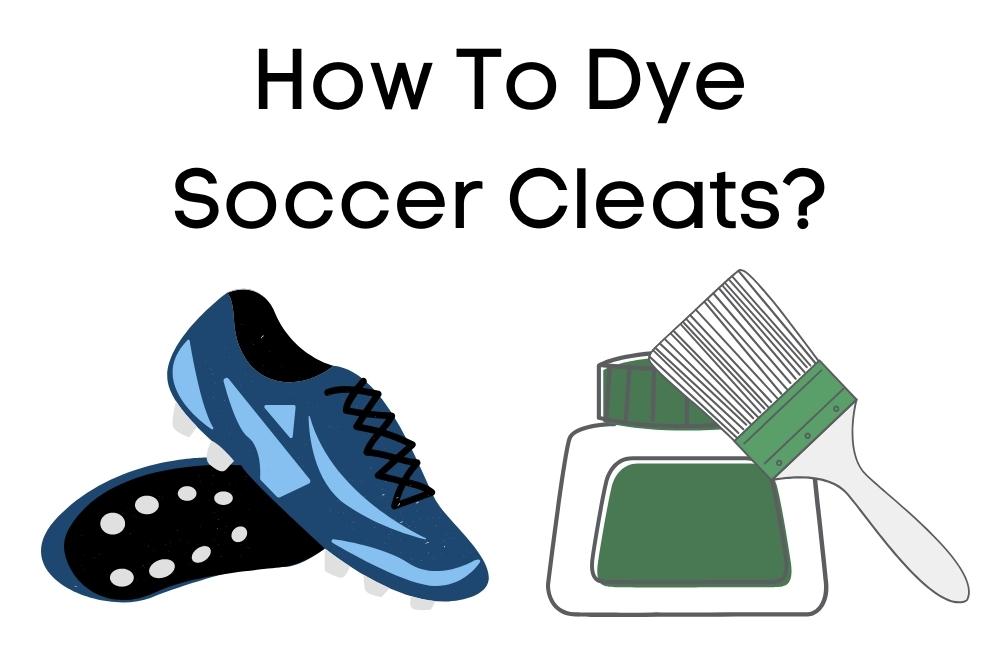Everyone has a particular preference when it comes to choosing a product. For some, it may be the color while for others it may be shape or pattern.
Considering the fact that there are over 3 billion soccer players and fans across the globe, it is simply impossible for manufacturers to satisfy all custom designs and colors of all the fans and players out there.
To solve this problem, many soccer cleat manufacturers often limit their products to basic colors. The end user now has the option of customizing soccer cleats as they like using dyes.
Key Takeaways
- People dye their soccer cleats to make them look unique and, in some cases, make it harder for others to steal them.
- Dyeing soccer cleats is cheaper than requesting custom-made designs from the manufacturer
- Alcohol-based dyes are preferable because they dry faster
- Dying soccer cleats can be done using a brush or by dipping the entire soccer cleat in a bowl of dye
Most people like looking unique when they step out in any outfit. However, the irony when it comes to sportswear is that you have to pay a steep price to acquire customized jerseys and boots.
Not everybody can afford customized sports equipment and the best way around that restriction is to dye the soccer cleats you have to your taste. Some of the dyeing methods require more skill than others to accomplish.
However, the good news is that anyone that really wants to dye their soccer cleats can do it if they have the right guidance. We will provide that step-by-step guide for you to make the job easier.
If you have been eager to dye your soccer cleats but don’t know what you need or how to start, keep reading to the end as we reveal the tips and tricks to you.
Quick Navigation
How to dye soccer cleats?
You can make your soccer boots look unique if you know how to customize soccer boots by dyeing them. A properly dyed soccer cleat can easily be mistaken for a rare collection produced by the manufacturer.
Sometimes, people use dyeing to mask an old pair of soccer cleats to give it an attractive newness. It is also a cheaper and highly efficient alternative to getting a new pair of soccer cleats.
When working with soccer cleats with laces, you can dye the laces to match the color of your soccer cleats. Without further chitchats, let’s dive into action.
Things to take note of before dyeing your soccer cleats
The thought of dyeing your soccer cleats can be exciting. However, before you get down to action, there is key information you need to know to avoid regrets.
Having this information beforehand can also help you to set your expectations so that you don’t feel disappointed at the end of the entire process. The key points to note are highlighted below.
Dye is permanent
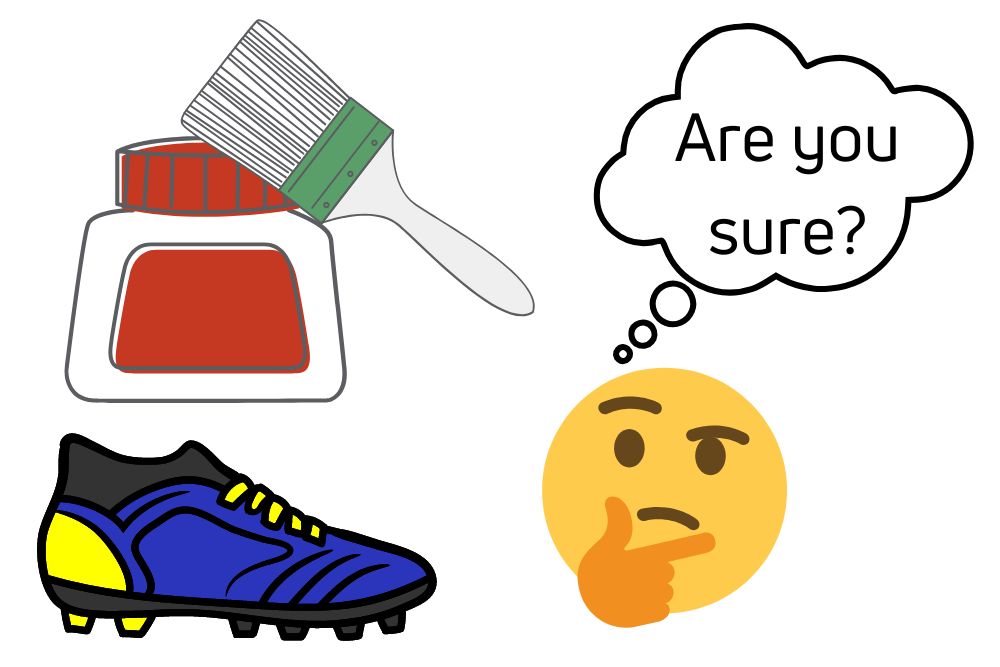
Before dyeing your cleats, be sure of your decision because reversing this process can be tough or impossible. You can ruin the cleats if you erroneously dye an unintended area.
Dyeing is not recommended for kids unless under the close supervision of an adult. Also, a procedure like this will void the warranty on your new soccer cleats. So, you must take full responsibility for your actions.
Dye doesn’t completely coat a surface
Unlike paint, a dye can alter the color of a cleat’s material but it can’t completely coat the surface of that material.
This simply means that the previous color of that surface may still be visible after dyeing. Therefore, you may need to apply your dye multiple times to get the desired glow.
Dyeing your leather cleats is similar to applying a faint layer of color on the surface. The dye color will mix with the previous color of the cleat, making it less vibrant.
If the previous color of the cleat is light, using a dye with a darker color will easily overlap it without necessarily dyeing the cleat multiple times.
Dye is unpredictable
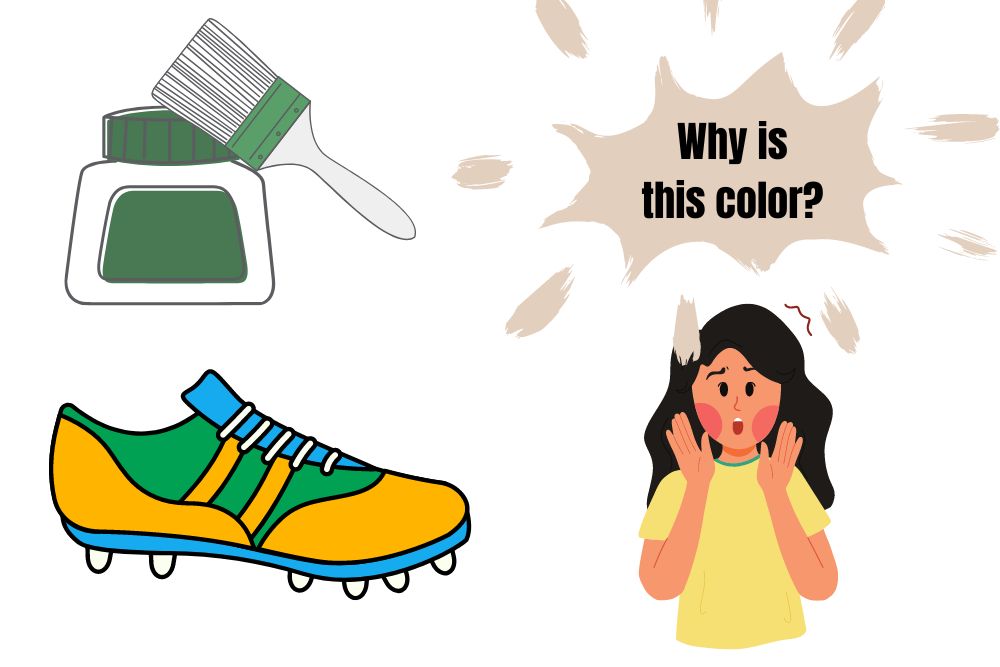
The outcome of all dyeing techniques is unpredictable and mildly experimental. Different materials respond differently to dye; some materials can be dyed faster than others.
Thus, it is difficult to predict with certainty how a soccer cleat will look after dyeing it.
If you aren’t willing to accept the outcome of this technique, just avoid using it. With dyes, patterns and results might be inconsistent.
Things you will need for dyeing your cleat
Now that you know the precautions to take when dyeing your soccer cleat, the next step is to look at what you will need.
To accomplish soccer cleat customization, you would need a couple of tools. We will mention them below.
1. Old clothes or a waterproof apron
- PACK OF 2: Kitchen suiting comprising of 2 elegantly tailored Bib Aprons, for the chefs fascinated...
- SMARTLY CRAFTED: Creatively woven from 100% Polyester Material, to forestall any spills or stains...
- FRONT POCKETS: Ideal for home or business use. The spacious divided pocket can give you enough place...
Last update on 2023-11-10 / Affiliate links / Images from Amazon Product Advertising API
It is advised to either wear old clothes or an apron when dyeing your shoes because there is a high tendency of the dye splashing on you no matter how careful you might be.
2. Protective rubber gloves
- Excellent Quality:Use high-quality Rubber gloves to protect your hands,Prevent hand skin from...
- Comfortable:The material of the cleaning gloves is very soft,and the inside has thin flocking for...
- Anti-slip Design:The palm and finger fish-scale pattern design increases friction,which can grab wet...
Last update on 2023-11-10 / Affiliate links / Images from Amazon Product Advertising API
Tight rubber gloves will protect your hands from getting stained by the dye. A dye stain on the hand doesn’t go away easily.
3. A stick or old spoon
The dye needs to be properly mixed when poured into water. Using your hands to do the mixing is not advisable.
4. Liquid dish soap
- Attacks grease and stains
- Fights hard-to-clean surface stains like coffee
- Phosphate-free
Last update on 2023-11-10 / Affiliate links / Images from Amazon Product Advertising API
Adding liquid dish soap to the mixture will help the dye mix properly with water and spread evenly.
5. A big bowl or container
This is what you will use for mixing the solution. Make sure it is big enough for your cleats to be totally submerged in it.
6. Dye
- QUICK COLOR DYE- Works just like a leather dye, but easier and without the mess. It will restore the...
- WONT CRACK, PEEL OR RUB OFF: Tarrago quick color dye will be completely solid and resistant to dry...
- EASY-TO-USE TO REPAIR SCUFFS & COLORS - Tarrago quick color easily fixes those scuffs, blemishes,...
Last update on 2023-11-10 / Affiliate links / Images from Amazon Product Advertising API
Alcohol-based dyes are preferable because they dry faster, are visible in vivid colors, and are easy to apply. They are better off than water or oil-based dyes especially when dyeing soccer cleats.
7. Water
Water is the most important part of this procedure. Make sure that the water is warm and clean.
8. A leather preparer
- An all-purpose cleaner and stripper for leather articles, this deglazer breaks down the original...
- Not recommended for use on vinyl or plastic
- Multi-purpose
Last update on 2023-11-10 / Affiliate links / Images from Amazon Product Advertising API
This helps in removing the glossy factory finish from leather soccer cleats. The shiny finish will prevent the leather from taking up the new dye.
9. Dye Fixative
- Locks in color to reduce bleeding, fading and even enhance the color of your fabric
- Perfect for dye projects and commercially dyed fabrics
- Use immediately after a tie-dye or dip-dye project to prevent dye from bleeding into white areas
Last update on 2023-11-10 / Affiliate links / Images from Amazon Product Advertising API
This helps in stopping the dye from fading or bleeding. It also reduces back staining while rinsing and washing.
10. Shoe polish
- PREMIUM WAX SHOE POLISH - Upgrade your basic shoe polish with the bold quality of Red Moose. Our...
- GLOSSY MIRROR-LIKE SHINE - If you like to dress to impress, you understand the importance of a...
- PROTECTS & PRESERVES LEATHER - Our wax shoe shine polish provides a hard, insulating wax layer to...
Last update on 2023-11-10 / Affiliate links / Images from Amazon Product Advertising API
To rebuild the finish of soccer cleats, you need to use quality shoe polish. Neutral shoe polish is better than colored polish.
11. Quality masking tape (optional)
- Masking tape for painting projects or light duty non-critical applications; for indoor use
- Includes 3 rolls of masking tape made of beige crepe paper with pressure-sensitive rubber adhesive...
- Not meant to be “sticky” to perform well; specifically designed adhesive ensures easy removal
Last update on 2023-11-10 / Affiliate links / Images from Amazon Product Advertising API
You will only need masking tape if there is a need to prevent certain areas of the cleats from getting dyed.
12. Soccer cleats
Of course, this procedure wouldn’t have any meaning without your soccer cleats.
13. Angled shader brush
This tool will help you control the amount of dye being applied on the surface of your soccer cleats, especially when working on cleats that are sensitive to hot water.
14. Scotchgard
- WATER REPELLENT SPRAY: Two Scotchgard Fabric Water Shields, 10 oz cans, that repel water-based...
- IDEAL FOR MANY HOUSEHOLD ITEMS: Water repellent spray is ideal for household items during the rainy...
- USE ON CLOTHING: Scotchgard Fabric Water Shield is perfect fabric spray for Summer outings for use...
Last update on 2023-11-10 / Affiliate links / Images from Amazon Product Advertising API
A waterproof spray for shoes that can repel oil-based stains.
Once you have all the materials you will need for the dyeing process ready, follow the steps below to give your pair of soccer cleats a new look.
Step 1: Get the soccer cleats ready
Before you start preparing your soccer cleat for dyeing, make sure you have changed into your old clothes or worn your waterproof apron. Don’t forget to wear your elastic rubber gloves.
Proceed to remove the laces and insoles of your cleats if they come with laces. Make sure the cleat is clean and dry then dab some leather preparer on a piece of cloth that you will use in removing the existing finish on your leather cleat.
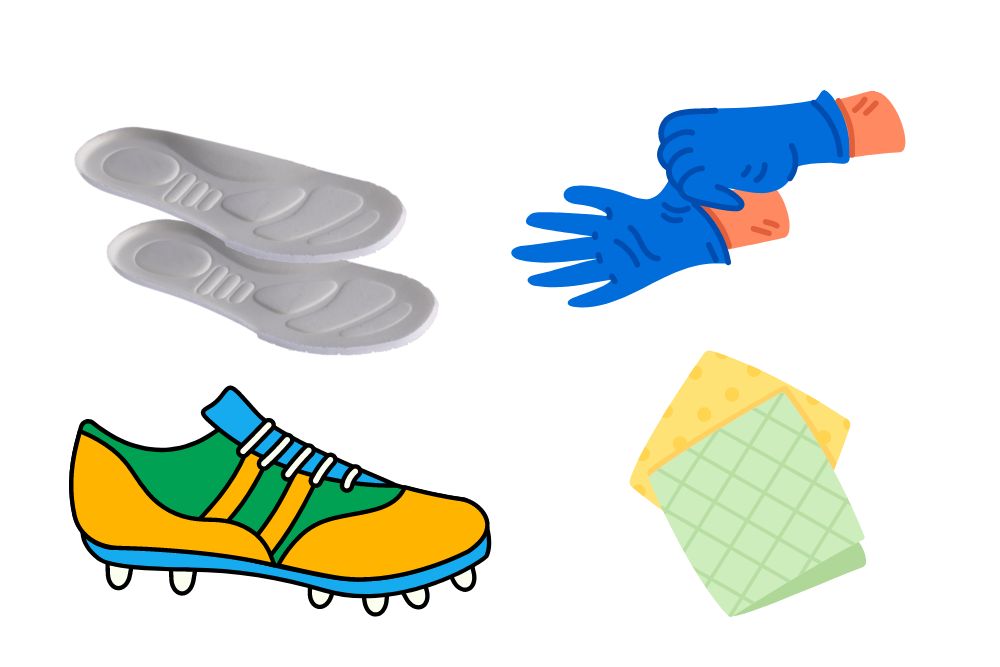
Remember to rub the leather cleat gently with the dabbed cloth when removing the finish. Don’t perform this task near an open flame or a place with little ventilation.
You wouldn’t need the preparer when dyeing synthetic cleats.
The color of the cleat will look lighter after removing the existing finish. Removing the finish on the leather cleat will help it absorb the dye better and faster.
Advance to masking parts of the cleat you don’t want the dye to reach by using masking tape. This is also the time to use your masking tape to form decorative patterns that the dye will eventually highlight.
Step 2: Test your colors
This step is important because, on some occasions, the color on the packaging of the dye may be slightly different from its content. This will also allow you to test the quality of the dye.
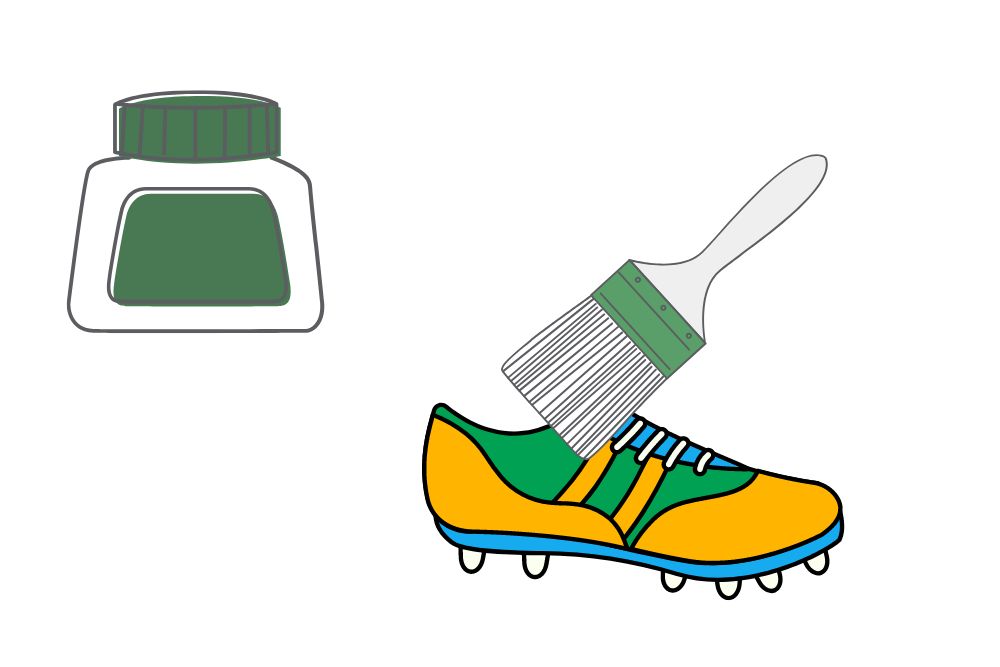
It is important to test your dye on a small portion of the cleat to know how it reacts with the surface of the cleat. Testing also allows you to combine colors to give your cleats an awesome color blend.
Step 3: Time to dye the shoe
Make sure warm water (about 50 degrees Celsius) is ready before opening the dye. The water should be sufficient enough to drown your cleats.
Not all cleats can withstand hot water. For soccer cleats that can’t withstand hot water, you can use a brush to apply the dye instead of dipping the entire cleat in hot water.
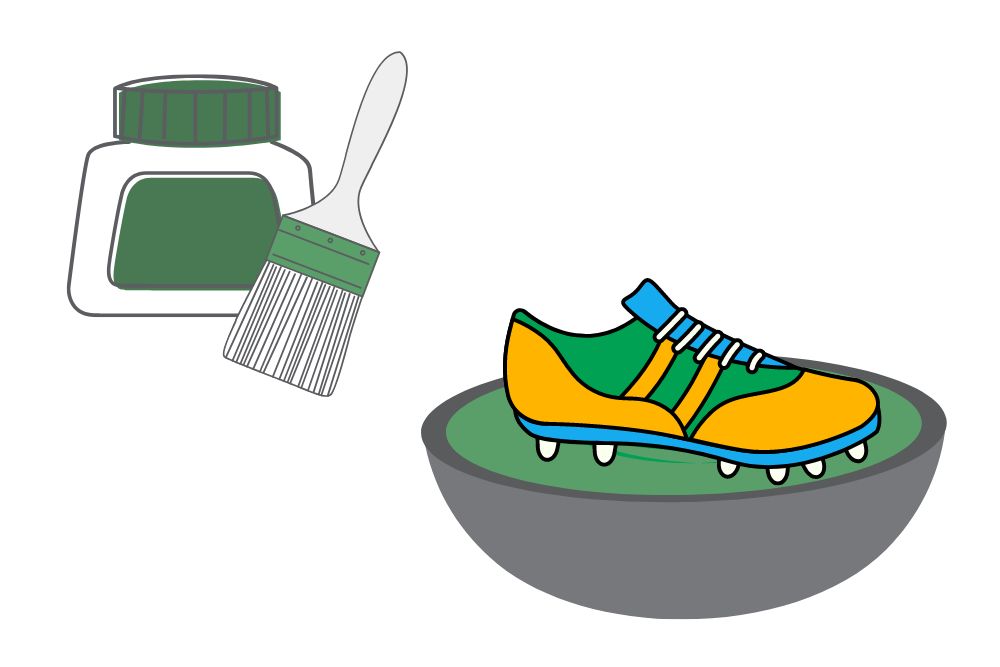
Simply dip the brush into the mixture and rub it off on the cleat until you get it dyed. Below is a guide on how to proceed from here:
- Properly read through the dye manufacturers instructions on the package
- Add 1 teaspoon of your liquid dish soap and a small quantity of the dye fixative to the warm water in a container
- Pour the dye into the mixture and stir for about a minute using a turning stick. Add more quantity of dye to the mixture to achieve a deeper color
- Get your cleats wet under a tap before submerging them in the dye solution. This is done to help the cleats absorb the dye faster
- You can keep the cleats submerged in the dye solution for as long as 10 to 60 minutes depending on how deep you want the color to be. Keep the soles facing upward so that the cleat’s upper will absorb much of the dye
- Remove the cleats from the dye and rinse them with cold water until the dye stops bleeding. This is also the time to remove any masking tape you might have initially put on the cleats
- You can now give the cleats a warm wash with your liquid dish soap and allow it to dry for about 12 hours
Step 4: Finishing
Dyeing doesn’t just end when the dyed cleat gets dry. You need to protect the dyed surface from damage, especially for leather cleats.
For a stronger shine and finish, it is preferable to use a neutral polish instead of a colored polish. A colored polish might make the cleat darker than you intended.
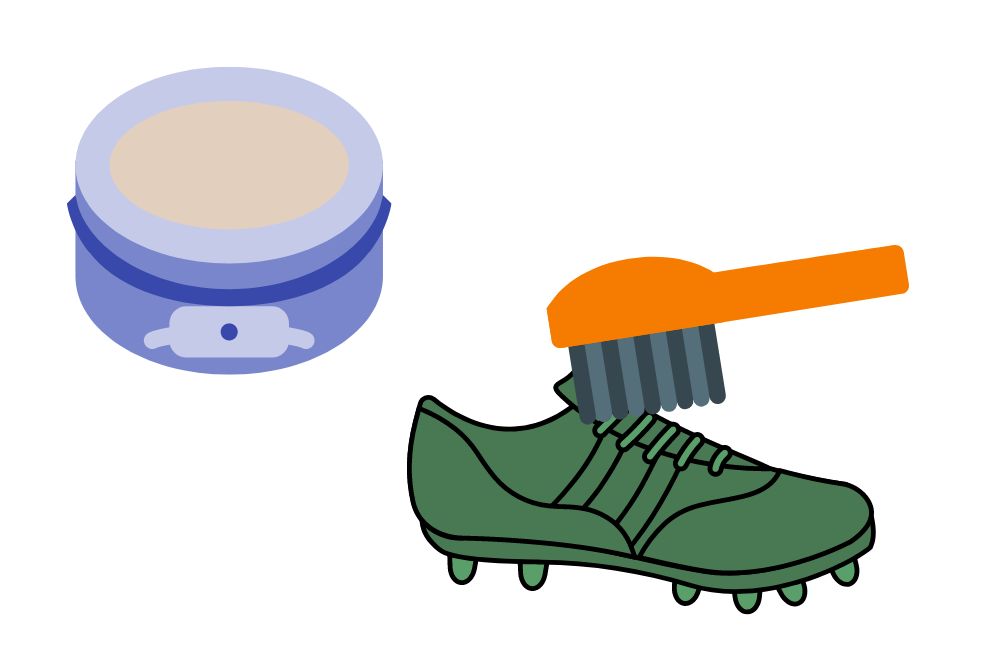
The polish must be applied gently to the cleat to avoid distorting the dye. When the polish gets dried up, use a dry brush and gently scrub off the residue.
You can re-polish leather cleats if you aren’t satisfied with how they look. Allow them to dry properly before taking them out to the stadium. Synthetic cleats can be sprayed with Scotchgard after drying.
Conclusion
Dyeing your soccer cleat is a good alternative to either inking or painting it. It is a good technique for altering the color of a large expense area of a cleat by applying minimal effort.
In other words, if you want to customize a large number of soccer cleats, dyeing can be a faster way of achieving the desired result.
To get the best result from dyeing, understand the color wheel. Soccer cleats cannot be dyed using colors alternating each other across the color wheel.
For example, a green cleat can’t be dyed orange. When you attempt to do that, you will end with a distorted color that is totally different from your expected outcome.
Also, don’t make the mistake of trying to bleach a dyed cleat after realizing you dyed it wrongly. Bleaching can damage the cleat’s material.
Hi there, I’m Jay.
Soccer is everything in my life! My friends and I have created this blog with all our enthusiasm, passion, and understanding after years of playing pro soccer. Hope you will enjoy it!
